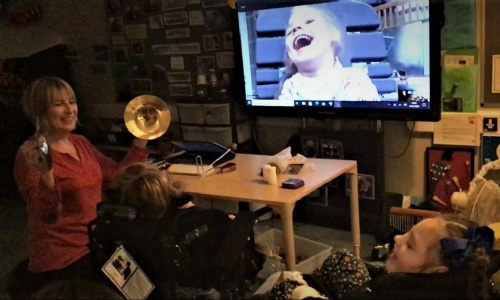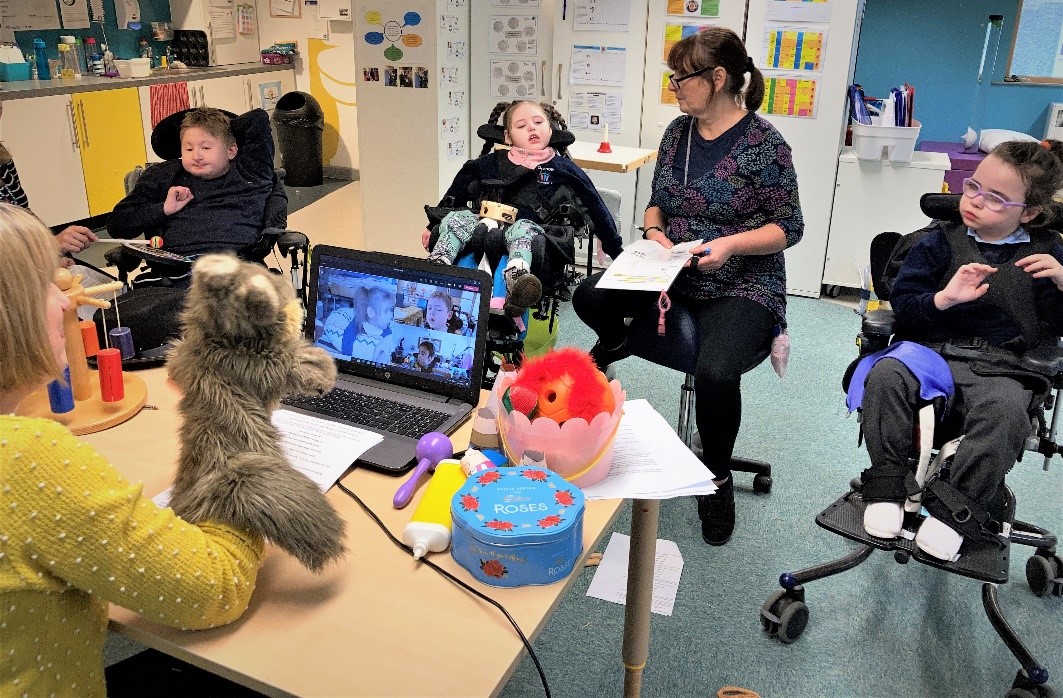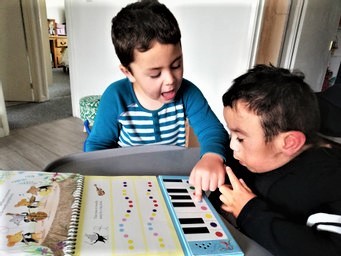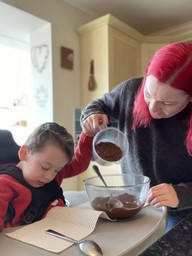Curnow School

The article produced by Curnow School on 'Our top 10 tips for providing a home learning offer' was included in the PMLD Link Magazine. Please see below to read the article.
The scale and the timescale of the COVID 19 pandemic will no doubt go down in history. Living through it the longevity and severity have been compounded by the changes in lifestyles, working patterns and for those in education the way that we have had to adapt to deliver the best quality education possible to the school population. For the Special School population this has provided major challenge, as our pupils learning styles and access to online teaching is extremely variable and individualised. This article aims to share the positive aspects of the changes we have made to our working patterns and what we will endeavour to continue as future practice.
Curnow School is an all aged special school set in Redruth, Cornwall. We were very lucky in Cornwall to have been one of the areas of Great Britain with smaller case numbers during the pandemic; however, in terms of our education system and the impact upon teaching we have faced the same challenges as the rest of the country. Being a special school our immediate thoughts when considering our home learning offer was how we could develop an offer which would be both manageable for our staff to resource and for our parents to deliver. We also knew that we faced challenges in the way that the learning would be accessed by our pupils and how much meaning this would hold for them. The great thing about being a special school is that having to think ‘outside the box’ is daily practice for our teachers. Once the initial concerns had been aired and deliberated over, the team got to work to consider what they could do to deliver the school offer in new and different ways. It soon became clear that the great relationships that we have with our parents was going to be key in moving forward if the offer was going to be a success.
For our PMLD cohort the meaningful delivery of sessions was a new and interesting challenge, but the pandemic restrictions severely limited our options. We were understandably sceptical about how much meaning a Teams link would have for our students, and we knew that empowering parents to be able to become the child’s learning partner would be the key to success. Jenny Buckland, our PMLD lead at Curnow outlines her initial concerns.
‘Once we knew that everyone was safe and well, our minds turned to how we would deliver our curriculum remotely. Being in class is very up close and personal, this way of working seemed so different to the everyday classroom experience. In school the curriculum is very rich and specialised, we wanted to make sure that we empowered parents to support the delivery of sessions in ways that held meaning and felt comfortable to them. We knew that some things would not be possible, for example working on the eye gaze, however, the provision of the COVID funding from the government allowed us to support in areas like physiotherapy and sensory curriculum more easily.’
The relationship with our parents has been key to the success of our home learning programme. Frequent contact, open dialogue and a commitment to getting things right for everyone has meant that many of our teachers became the main ‘go to’ for parents on a wide range of issues and concerns, which has resulted in even further strengthened relationships with our families. One of our parents, Joy Constable, explains how the lockdown affected her family and what the support of the school community has meant to her family during this difficult time.
‘I had no worries about how my child would access a home learning offer...on the contrary, I was intrigued as to how it would work. The communication and innovation of her class teacher...Jenny Buckland, was exemplary, my child lacked for nothing, and I felt totally supported through telephone, email and class Dojo routes. The fact that Jenny has helped us as parents, build links with other parents was a huge help as well. I never once felt "out on a limb", I never felt as if I was just being left to "get on with it". Considering the calibre of not only actual resources, but the clear and concise, but never condescending explanations that came as well...lockdown was quite a time for me to learn with my child. The on screen face to face, for her was invaluable, and I firmly believe that all these things led to a very seamless return to school. To summarise, my initial reaction was one of intrigue, and I had no worries about how it would work...I have faith in her teacher, and her school. I have started to learn "how" my child learns....and that's been awesome. I have always been a "re use and recycle" type of person, but since lockdown, Jenny has shown me lots more uses for everyday household objects!! On a personal level, lockdown and home learning has allowed me to slow down a bit, and really rejoice in the small steps of life. It has truly taught me that there is no such thing as a silly question, and I do believe it has enhanced the relationship I have with her teacher, and therefore made me even more comfortable when leaving her at school.
Would I like to go through another lockdown.....only if the sun was shining !!!!!’

On return to school we conducted a home learning survey, allowing us to get a full picture of the most useful ways to support children at home and this has enabled us to inform the lessons that we will embrace and draw on for the future. These will help us to provide better support for children in need of periods of home learning, due to illness or vulnerability, meaning that no child’s educational provision should be paused because they are unable to attend the school. These are our top 10 tips for providing a solid and supported home learning offer.

- SET UP DAILY ROUTINES THAT MIRROR THE SCHOOL OFFER.
In school we used Class Dojo a lot to provide videos of transitional songs, morning and afternoon routines and examples of regular daily sessions. Setting up the routines to be used at home allowed the parents to provide structure to the days and has also really supported the children to reintegrate back into school life.
- PROVIDE INFORMATION ON HOW AND WHY SESSIONS ARE DONE IN SCHOOL.
Once an adapted timetable was set, staff were able to provide brief information sheets explaining the how and why of specialist sessions. This then allowed the parents supporting the children to understand the session intentions and look for the responses linked to that. Parents now have a deeper understanding of how and why we teach as we do.
- CONSIDER HOW OFTEN A TOPIC WILL CHANGE.
In school we will continue a topic area for a half term on average allowing the consolidation of skills and for children to build on anticipation. For parents this was not always the best time scale, so during lockdown we worked on 2/3 week cycles. Open dialogue after time allowed us to adjust our offer where necessary, for example where parents did not want to change so frequently.
- SEND HOME PACKS OF RESOURCES LINKED TO SESSIONS BEING DELIVERED.
This sounds so obvious, but some of the things that we have and use in school on a frequent basis were not readily available to all – e.g. scarves or sensory materials. We also had to take into account that not everyone was able to get the resources due either to shortages or access restrictions. This, of course, will be true of future packages being delivered to children who are ill or vulnerable.
- FILM DEMO’S, USING CHILDREN WHERE POSSIBLE/RELEVANT.
Some teachers used their own children at home, and some used children who were still attending school to film activity demonstrations. Activities like massage stories work well like this as you can really show the pace and the key language in action. We will be taking this forward in future to deliver awareness sessions/training for families.
- SET UP TEAMS LINKS FOR SESSIONS.
Once all of the materials had been delivered the teachers were able to provide small group Teams links, allowing the children to see each other on screen and hear each other’s noises as well as hearing the teacher. Again this has really helped with reintegration, but has also allowed some parents to meet each other and to see the other children when this would not have been possible.
- SET HOME FRIENDLY IEP’S
This was a really good way to support progress at home, while maintaining an area of assessment. The IEP targets linked directly to the EHC plan and were adapted and resources so that they could be delivered in the home by parents.
- USE VIDEO CALLS WITH CHILDREN.
Some of the most successful interactions were conducted using video calls, and some of the children were able to connect directly with each other using this method. Without the pandemic this would not have happened, but post pandemic some of the children are still keeping in touch this way! The children loved seeing and hearing their teacher and other classroom staff over the video calls that were made.
- CONDUCT DOORSTEP OR GARDEN VISITS.
The visits to the parents – socially distanced! - were a great way of showing support, delivering resources and of giving less formal advice and guidance. These visits often led to conversations that would not have happened in a more formal phone call and were very much welcomed by families as they reduced the sense of social isolation.
- TRY ANYTHING!
Some of the most successful methods were initially those that we thought would not work. Our children are remarkably resilient and resourceful and have surprised us in many ways, and our parents are always keen to learn new ways to support and connect with their children.

All the resources my child would have had in class have come home, with clear instructions
It was fun and informative learning how they learn and we have all enjoyed doing it.
The work packs sent home were amazing! There was always enough for us to do and a big variety. The teacher was always on hand to offer support with this.
Really useful to have a daily message/video from the teacher, it helped my son to manage his day.
During lockdown my son was always made to feel part of the class. The live lessons were amazing and as parents we were able to see the true friendships between our son and his friends. Thank you - you are all amazing!
Parent comments – Home Learning Survey March 2021
